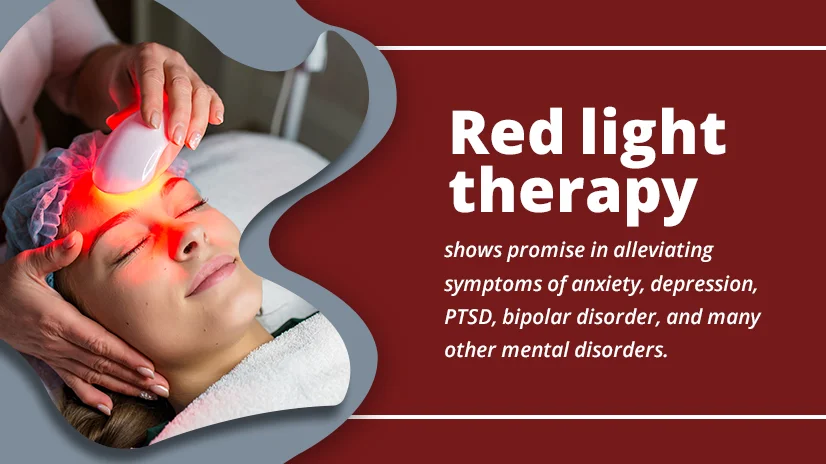
Understanding Narcissistic Personality Disorder (NPD)
Explore the symptoms, causes, and treatments for narcissistic personality disorder with Indiana Center for Recovery.
Red light therapy (RLT) is gaining attention for its potential benefits beyond physical healing. Recent research suggests that this non-invasive treatment, using specific wavelengths of red and near-infrared light, may positively affect mental health conditions.
Unlike traditional therapies, red light therapy doesn’t involve medication or invasive procedures, making it a promising alternative for those seeking natural approaches to mental wellness. Keep reading as we delve into the crucial role of this therapy in mental health care.
Red light therapy (RLT) utilizes specific wavelengths of light to potentially improve mental health and overall well-being. This article covers:
Contact Indiana Center for Recovery at (844) 650-0064 to explore how our services can support your mental health journey.

Red Light Therapy (RLT), or low-level laser therapy (LLLT), is a non-invasive treatment method that utilizes low-level red light wavelengths to promote healing and reduce pain. This therapy is based on the principle that certain wavelengths of light can penetrate the skin and stimulate cellular function.
RLT traces its origins to NASA’s research in the 1990s, where it was used to grow plants in space. Scientists observed that red light helped promote cell growth and tissue repair. Over time, this technology transitioned to therapeutic use in healthcare and wellness fields.
Here are the common types of red light therapy devices:
These devices differ in intensity, wavelength range, and coverage area, allowing flexibility in treatment protocols for conditions like skin disorders, musculoskeletal injuries, and even mental health issues.
Red light therapy (RLT) offers a promising approach to enhance healing and support mental health. Here’s how it works:
Red light therapy utilizes wavelengths of light to penetrate the skin without causing harm. These wavelengths are absorbed by mitochondria, the powerhouses of cells, where they stimulate energy production. This boost in cellular energy promotes healing and reduces inflammation. Moreover, red light affects the brain by increasing blood flow and promoting the release of serotonin, a neurotransmitter associated with mood regulation.
At a cellular level, red light therapy triggers various biological responses. It enhances mitochondrial function, increasing ATP (adenosine triphosphate) production, which fuels cellular processes and accelerates tissue repair. Additionally, red light therapy modulates oxidative stress, reducing inflammation and pain. The brain influences neural activity and neurochemical balance, contributing to improved mood and cognitive function.
By understanding its mechanisms, we can explore how this therapy enhances cellular function and potentially improves overall well-being.
Red light therapy (RLT) shows promise in addressing various mental disorders through its non-invasive approach and potential to influence cellular functions positively.
Major depressive disorder (MDD), a common mental health condition marked by insistent sadness and loss of interest, may benefit from red light therapy. Research suggests that RLT can help regulate neurotransmitter levels and promote neuroplasticity, potentially alleviating symptoms.
Anxiety disorders, including generalized anxiety disorder (GAD) and social anxiety disorder, involve excessive worry and fear. Red light therapy’s ability to modulate brain activity and reduce inflammation may contribute to calming effects, offering relief from anxiety symptoms.
Seasonal affective disorder (SAD) is a type of depression that arises seasonally, typically in the winter months. RLT’s influence on circadian rhythms and mood-regulating neurotransmitters may help mitigate symptoms of SAD, such as low energy and mood disturbances.
Sleep disorders like insomnia and disrupted sleep patterns can significantly impact mental health. Red light therapy RLT’s influence on melatonin production and circadian rhythms can aid in regulating sleep patterns and improving overall sleep quality.
Post-traumatic stress disorder (PTSD), often triggered by traumatic experiences, involves symptoms like flashbacks, hypervigilance, and mood swings. Red light therapy’s ability to lessen oxidative stress and enhance cellular repair mechanisms may aid in managing PTSD symptoms and promoting emotional stability.
Bipolar disorder is marked by extreme mood swings, which include manic highs and depressive lows. While more research is needed, early studies suggest that red light therapy’s impact on neurotransmitter balance and cellular function could help stabilize mood shifts in bipolar disorder.
While more research is needed to fully understand the extent of red light therapy’s benefits for mental health, initial findings are promising.
Red light therapy (RLT) offers a range of potential benefits for mental health, supported by emerging research into its effects on the body and brain.
Stress is a common issue that impacts mental and physical health. Red light therapy (RLT) can help lessen stress by promoting relaxation and reducing cortisol levels, the body’s primary stress hormone. This therapy encourages a sense of calm, helping people manage stress more effectively.
RLT can improve sleep quality by regulating melatonin production, the hormone responsible for sleep-wake cycles. By mimicking natural sunlight, RLT helps to reset the body’s internal clock, making it easier to fall asleep and stay asleep. Better sleep quality can significantly enhance overall mental well-being.
Anxiety and depression are common mental issues that RLT may help alleviate. The therapy stimulates the production of serotonin and dopamine, neurotransmitters that regulate mood. This can result in a decrease in signs and symptoms of anxiety and depression, helping individuals feel more balanced and positive.
Cognitive function and mood are closely linked. RLT can enhance cognitive abilities such as memory, attention, and processing speed. It can also improve mood by increasing blood flow to the brain and stimulating the release of endorphins, the body’s natural feel-good chemicals.
Neuroprotection refers to the preservation of nerve cells and brain function. RLT’s ability to reduce oxidative stress and inflammation helps protect neurons from damage. This neuroprotective effect can slow the progression of neurodegenerative diseases and support long-term brain health.
Mental health is closely tied to energy levels. RLT can boost energy by stimulating cell ATP production, increasing cellular energy. Higher energy levels can improve motivation, reduce fatigue, and enhance overall mental and physical performance.
As research continues to explore these benefits, red light therapy (RLT) may become a valuable addition to mental health treatment plans.
Red light therapy (RLT) is generally considered safe, but like any medical treatment, it has potential risks and side effects that should be understood.
Short-term side effects of RLT are usually mild and temporary. These may include:
These side effects typically resolve on their own shortly after treatment.
While short-term side effects are minimal, the long-term safety of RLT is still being studied. Concerns include:
Long-term safety concerns emphasize the importance of using RLT under professional supervision and adhering to recommended guidelines.
RLT may not be suitable for everyone. Certain conditions and situations may contraindicate RLT or require precautions, including:
Understanding these contraindications and precautions ensures the safe and effective use of RLT for mental health and other therapeutic purposes.
Red light therapy (RLT) can be easily incorporated into your home routine with the right equipment and an understanding of recommended protocols.
To begin with, RLT, choosing a device that emits appropriate wavelengths of red and near-infrared light is essential. Look for FDA-cleared devices that specify the wavelengths used and ensure they suit your intended use. Setting up involves placing the device at the recommended distance from your skin, typically around 6 to 12 inches, depending on the device’s specifications. Create a comfortable and quiet environment where you can relax during your sessions.
For effective RLT, establish a consistent treatment protocol based on session duration and frequency. Typically, therapy sessions range from 10 to 20 minutes, depending on the device’s intensity and treatment area. Start with shorter therapy sessions and gradually increase the duration as tolerated. Frequency varies, but most users initially benefit from 3 to 5 sessions per week, then adjust based on individual responses. Avoid exceeding recommended dosages to prevent potential side effects.
By following these practical tips and guidelines, you can effectively harness the potential benefits of red light treatment for improved mental and physical well-being.
Red light therapy has shown the potential to positively impact emotions by helping to reduce feelings of mood disorders. The gentle red wavelengths are thought to stimulate the production of serotonin and endorphins, neurotransmitters that result in feelings of well-being and happiness.
This therapy may also help regulate sleep patterns, improving overall mood. While more research is needed, initial studies suggest that red light therapy could be a non-invasive way to support emotional health alongside other treatments. Always speak to a healthcare professional for personalized advice.
Red light therapy affects the brain by penetrating the scalp and skull to reach brain tissue. It’s believed to enhance cellular function in the brain, promoting better circulation and reducing inflammation. This process can improve cognitive function, memory, and mood regulation.
Research suggests that red light therapy may have neuroprotective effects, helping to protect brain cells from damage. While more studies are needed to understand its impact fully, some evidence indicates that this therapy could be helpful for conditions like traumatic brain injury and neurodegenerative diseases.
For mental health improvement using red light therapy, it’s recommended to start with sessions several times per week. Each session typically lasts about 10-20 minutes, depending on the device and the area being treated. Consistency is key, so regular use over weeks to months may provide the best results.
However, the frequency and duration can vary based on individual needs and the specific condition being addressed. It’s important to discuss your treatment plan with a healthcare provider to make sure it aligns with your overall mental health goals and any other treatments you may be receiving.
Indiana Center for Recovery is here to support you every step of the way. Our inpatient psychiatric services are tailored to meet the complex needs of individuals facing intricate mental health challenges.
We offer proven therapies like cognitive behavioral therapy (CBT), expert medication management, innovative treatments such as TMS therapy, and supportive services like family counseling and group therapy. If your mental health struggles have also led to substance use issues, our dual diagnosis program provides integrated treatment to address both aspects effectively.
Contact us at (844) 650-0064 to learn how we can help you regain control and find healing.
